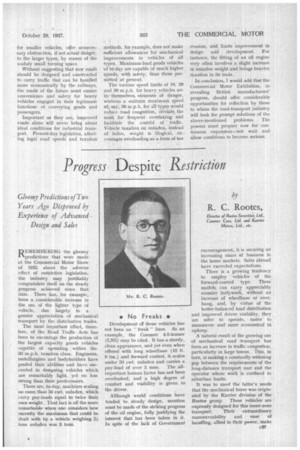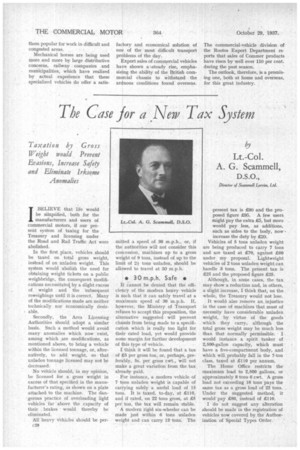Progress Despite Restriction I? y
Page 89

Page 90

If you've noticed an error in this article please click here to report it so we can fix it.
R. C. Rootes,
Gloomy Predictions of Two Years Ago Disproved by Experiekce of Advanced Design and Sales
REMEMBERING the gloomy ‘predictions that were made at the Commercial Motor Show
of 1935 about the adverse effect of restrictive legislation, the industry may justifiably congratulate itself on the steady progress achieved since that date. There has, for example, been a considerable increase in the use of the lighter type of vehicle, due largely to a treater appreciation of mechanical transport by the distributive trades.
The most important effect, therefore, of the Road Traffic Acts has been to encourage the production of the largest capacity goods vehicles capable of operating within the 30 m.p.h. taxation class. Engineers, metallurgists and bodybuilders have pooled their abilities and have succeeded in designing vehicles which are remarkably light, yet no less strong than their predecessors. .
There are, to-day, machines scaling no more than 50 cwt. unladen, which carry pay-loads equal to twice their own weight. That fact is all the more remarkable when one considers how recently the maximum that could be dealt with by a vehicle weighing 21 tons unladen was 3 tons.
• No Freaks •
Development of these vehicles has not been on " freak " lines. As an example, the Commer 4-5-tonner (LN5) may he cited. It has a sturdy, clean appearance, and yet even when offered with long wheelbase (13 ft. 9 ins.) and forward control, it scales under 50 cwt. unladen and carries a pay-load of over 5 tons. The all-. important human factor has not been overlooked, and a high degree of comfort and visibility is given to the driver.
Although world conditions have tended to steady design, mention must be made of the striking progress of the oil engine, fully justifying the interest that has been taken in it. In spite of the lack of Government encouragement, it is securing an increasing share of business in the home markets. Sales abroad have exceeded expectations.
There is a growing tendency to employ vehicles of the forward-control type. These models, can carry appreciably roomier bodywork, without an increase of wheelbase or overhang, and, by virtue of the better-balanced load distribution and improved driver visibility, they are safer to operate, easier to mancenvre and more economical in upkeep.
A natural result of the growing use of mechanical road -transport has been an increase in traffic congestion, particularly in large towns. This, in turn, is making a constantly widening gap between the requirements of the long-distance transport user and the operator whose work is confined to suburban limits.
It was to meet the la.tter's needs that the mechanical horse was originated by the Karrier division of the Rootes group. These vehicles are expressly designed for this inner-zone transport. Their extraordinary maneeuvrability and ease of handling, allied to their power, make them popular for work in difficult and congested areas.
Mechanical horses are being used more and more by large distributive concerns, railway companies and municipalities, which have realized by actual experience that these specialized vehicles do offer a satis
factory and economical solution of one of the most difficult transport problems of the day.
Export sales of commercial vehicles have shown a ',steady rise, emphasizing the ability of the British commercial chassis to withstand the arduous conditions found overseas. The commercial-vehicle division of the Rootes Export Department reports that sales of Commer products have risen by well over 110 per cent. during the past season.
The outlook, therefore, is a promising one, both at home and overseas, for this great industry.
























































































































































































